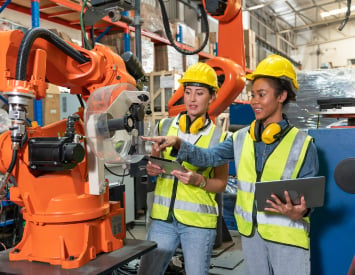Airless tires are not new, but their most recent application suggestions give insight into the importance of perfecting the design.
Tires are used constantly, but the simple idea of creating a round fixture on moving objects that is less likely to explode is just one of the reasons airless tires came around.
Unlike other airless options like PermaTubes in bicycles, the airless tires of this decade are keenly designed to not be a singular unit, but an engineering design optimization exercise.

Pneumatic Tires vs Airless Tires
The major problem with pneumatic tires is the fact that it degrades and it struggles to work with mechanical damage.
Airless tires made from elastic polymeric materials have become the answer and a lot of new literature explores the possibilities of the airless automotive tire.
The 2021 paper Design optimization of Airless Tyre – Numerical Approach shines a light on the differences between traditional tires and why the change is taking place.
For the authors, the success of airless tires will be the fact that it’s a combination of
tire and wheel.
The perfect tire will have a metallic centre point, polyurethane for balance and an external ring around it. This design allows the tire to avoid underneath pressure which pneumatic tires need to do.
On different landscapes, the adaptable spokes of the wheel (hexagon-shaped pockets within the tire) can twist and function as vehicles operate.
While the tires almost look like whiffle balls their design is sound and it seems very effective. Michelin, one of the world’s foremost tire manufacturers have already tested and approved a line of tires following the new design of airless tires.
These tires have greater performance capabilities which translate to comfort.
Most importantly an airless tire has its stiffness and contact stress governed through geometric and material parameters that will be far more adaptable than traditional pneumatic tires, optimizing tires tenfold.
So how is it designed?
There are many different airless tire designs but some of the main practical designs consider several engineering principles.
- Using the Peltier effect
The Peltier effect can increase tire durability according to the paper Ways to Improve the Durability of Pneumatic Tires. One limit to the durability of tires is heating at hyper-velocities.
The thermal problem concerns pneumatic and airless tires. The optimum mode of tires is the temperature from 70 to 750C.
When heated to 1000C the durability and bond strength between rubber and its cord is reduced up to two times. The proposal of a new structure of the tire material and thermal effects need to be considered.
- Creating new spokes
Another paper Comparative Study on Airless Tyre of Different Spoke Structure on Aircraft also considers the safety of airless tires, and that a lot of its value will be in a spoke design.
The paper mentions that with airless tires there are no blow-outs and road accidents are inherently reduced. Again, the design relies on a solid internal hub, attached to an axle and enveloped in polyurethane.
This combination forms a wedge pattern that can absorb the effects of the terrain the wheels are used on.
It’s approved and likely to hit the market soon
Last year Michelin proclaimed their airless tire technology is approved and could hit the shelves as early as 2024.
According to the company, the need for air is eliminated with a structure capable of supporting the vehicle, while also delivering a safe, comfortable ride using the established realms of creating new spokes and different materials.
Hankook tires similarly unveiled their i-Flex tires at the start of 2022.
The i-Flex is a non-pneumatic concept tire with a biomimetic design.
“To absorb road shocks and bear a load, it adopted the design of a multi-layer interlocking spoke inspired by the cellular structure of living organisms,” the company says in their latest press release on the tire.
The multi-layer interlocking spoke structures features hexagonal and tetragonal cell structures for more stable load support.
Why airless tires will be valuable and environmentally friendlier
Firstly, airless tires could potentially be created easily and effectively through technology like 3D printing. On top of that these tires optimize waste, as fewer tires will end up in landfills.
The paper Design of 3D printable airless tyres using NTopology gives good insight into the pros of the new designs.
According to the authors around 200 million tires are discarded annually due to premature puncturing or some of the other factors pneumatic tires are prone to.
Airless tires on the other hand offer a solution in that these tires are considered safer but also reduce the raw material required to produce traditional tires. This reduces the overall carbon footprint in the manufacturing chain. It’s also believed that these tires will reduce fuel consumption.
At the end of the day, it is a strong design and change in material that proves the value of airless tires as a means to communicate how effective engineering has a milliard of positive outcomes, in this case, road safety and sustainability.
References:
R, Sanjeev Kumar & Kumar, K Vetrivel & Ramakrishnan, T. (2021). Design optimization of Airless Tyre – Numerical Approach. IOP Conference Series: Materials Science and Engineering. 1057. 012032. 10.1088/1757-899X/1057/1/012032.
Evseev, D & Kotesova, A & Kosenko, V & Golubeva, A. (2019). Ways to Improve the Durability of Pneumatic Tires. IOP Conference Series: Materials Science and Engineering. 698. 066032. 10.1088/1757-899X/698/6/066032.
Dronavajhula, Kashyap & Reddy, Alavala & Mattapelli, Arun & Vihar, R & Govardhan, D. (2021). Comparative Study on Airless Tyre of Different Spoke Structure on Aircraft. International Journal of Engineering and Technical Research. 10. 827.
Hankook Technology, 2022. Hankook Tire exhibits futuristic airless concept tire i-Flex at CES 2022. [online] Available at: https://www.hankooktire.com/global/about-hankook-tire/media-center/press-room.70736.html?div=&text=&selsort=&tab=all&page=1 [Accessed 19 January, 2022]


